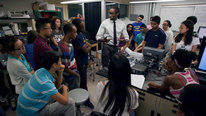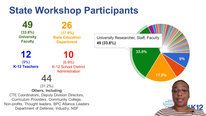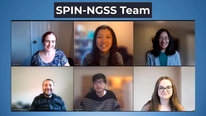- Heather Griller Clark
- Principle Research Specialist
- Presenter’s NSFRESOURCECENTERS
- Arizona State University
- Annee Grayson
- Research Analyst Assistant
- Presenter’s NSFRESOURCECENTERS
- Arizona State University
- Ally Hunter
- post-doctoral research fellow
- Presenter’s NSFRESOURCECENTERS
- University of Massachusetts Amherst
- Michael Krezmien
- Professor
- Presenter’s NSFRESOURCECENTERS
- University of Massachusetts Amherst
- Sarup Mathur
- https://education.asu.edu/sarup-mathur-0
- Professor
- Presenter’s NSFRESOURCECENTERS
- Arizona State University
- James Short
- Project Manager
- Presenter’s NSFRESOURCECENTERS
- Arizona State University
INSITE: INtegrating STEM Into Transition Education for Incarcerated Learners
NSF Awards: 1920550
2021 (see original presentation & discussion)
Grades 9-12
Incarcerated youth have some of the poorest post-secondary outcomes of any adolescent learners. In general, they have fewer vocational skills and opportunities, limited or no job experience, and as a result are unemployed, underemployed, and experience poverty and homelessness at rates substantially higher than other youth. This population is often an afterthought when it comes to implementation of new or innovative education or programming.
This project, entitled INSITE (INtegrating STEM Into Transition Education), is developing a modified model of the Social Cognitive Career Theory specific to marginalized populations of learners and evaluating the adequacy of the model for explaining STEM career readiness. In our model, we propose that our STEM Transition Curriculum will improve STEM career learner outcomes, which shape cognitive variables including, STEM outcome expectations, STEM interest, and STEM self-efficacy, which impact STEM Career Readiness. Our baseline data examines the influence of STEM contextual variables on the cognitive variables that lead to STEM career readiness.
INSITE hopes to broaden STEM participation for highly marginalized and vulnerable learners by providing a STEM career transition curriculum, exploring relationships between contextual/cognitive variables and career readiness, and preparing and connecting incarcerated learners to STEM employers.
Related Content for INSITE: Understanding STEM Career Readiness of Incarcerated
-
 2020INSITE: Exploring STEM Careers with Incarcerated Learners
2020INSITE: Exploring STEM Careers with Incarcerated Learners
Heather Griller Clark
-
 2018RAISE: STEM Career Development for Incarcerated Youth
2018RAISE: STEM Career Development for Incarcerated Youth
Karen Harrington
-
 2018STEPs to STEM
2018STEPs to STEM
Jill Stockwell
-
 2017ASSisT: Alliance to Strength the STEM Tapestry
2017ASSisT: Alliance to Strength the STEM Tapestry
Matt Whittaker
-
 2020STEM Opportunities in Prison Settings (STEM-OPS)
2020STEM Opportunities in Prison Settings (STEM-OPS)
Eden Badertscher
-
 2022STEM Opportunities in Prison Settings
2022STEM Opportunities in Prison Settings
Terrell Blount
-
 2018Exploring strategies for integrating computational thinking
2018Exploring strategies for integrating computational thinking
Diane Ketelhut
-
 2022Connecting Youth to STEM Career Pathways
2022Connecting Youth to STEM Career Pathways
John Ristvey
Playlist: ECR-EHR Core Research Videos Playli…
ECR-EHR Core Research Videos Playlist
-
 2021Sciencing from Home During the Pandemic
2021Sciencing from Home During the Pandemic
Saira Mortier
-
 2021Staying in Science: STEM Pathways through Mentored Research
2021Staying in Science: STEM Pathways through Mentored Research
Rachel Chaffee
-
 2021STEM Cascades: Youth as Teachers and Mentors
2021STEM Cascades: Youth as Teachers and Mentors
Eli Tucker-Raymond
-
 2021Inclusion and Math Class
2021Inclusion and Math Class
Nathanial Brown
-
 2021Keeping the focus on dimensions of quality math discourse
2021Keeping the focus on dimensions of quality math discourse
Paola Sztajn
-
 2021Helping States Plan to Teach AI in K-12
2021Helping States Plan to Teach AI in K-12
Christina Gardner-McCune
-
 2021INSITE: Understanding STEM Career Readiness of Incarcerated
2021INSITE: Understanding STEM Career Readiness of Incarcerated
Heather Griller Clark
-
 2021Virtual PD for STEM Teachers—Lessons for a New Landscape
2021Virtual PD for STEM Teachers—Lessons for a New Landscape
Sarah Michaels
-
 2021Big Data from Small Groups
2021Big Data from Small Groups
Asmalina Saleh
-
 2021Building Community to Shape Emerging Technologies
2021Building Community to Shape Emerging Technologies
Judi Fusco
-
 2021Theory-based Computational Analysis of Classroom Video Data
2021Theory-based Computational Analysis of Classroom Video Data
Christina Krist
-
 2021Racial Equity in the STEM Math Pathway in Community Colleges
2021Racial Equity in the STEM Math Pathway in Community Colleges
Helen Burn
-
 2021Student Reasoning Patterns in NGSS Assessments
2021Student Reasoning Patterns in NGSS Assessments
Lei Liu






Heather Griller Clark
Principle Research Specialist
Welcome to our INSITE video page. Over the past year we have focused on co-designing the STEM transition curriculum with youth and teachers from the Arizona Department of Juvenile Corrections, and assessing the STEM knowledge and career interest of the youth. We are also addressing barriers to successful STEM employment for youth by engaging local employers in identifying their needs and potential knowledge or skill gaps in the curriculum.
We plan to analyze the impact of the curriculum, once it is fully developed, on STEM career knowledge, competencies, readiness, and outcomes. We also plan to use Social Cognitive Career Theory (SCCT) as a framework for exploring what STEM jobs incarcerated youth are interested in and whether or not the path to a STEM job is different because of contextual variables germane to the setting.
What are your thoughts? How do you think the context of juvenile justice impacts STEM career development?
Please comment or ask questions. Thank you for viewing
Ally Hunter
Brian Drayton
This is really interesting. How does it connect with information/advice about content or skills preparationi for the pathways that attract them?
Heather Griller Clark
Principle Research Specialist
Thank you for your question Brian. The app is used in a vocational class that is focused on career exploration and preparation for release and reentry into the community. As students progress through the curriculum their responses to the content guide them to examine their personal and workplace values and goals, and set timelines for accomplishing these. Their responses are used to build a transition plan, with these goals and objectives fully articulated, as well as a resume and other products relevant to reentry.
The curriculum also contains content on soft workplace skills, like interviewing, communication, and problem solving. We have cultivated the involvement of local STEM employers, both virtually and in person, to assist us in embedding real world experiential learning through STEM job talks, STEM job fairs, and mock interviews.
Yolanda Abel
Maia Punksungka
Yolanda Abel
Associate Professor
Sounds like a very practical application tat might have impact in easing the transition back to life outside of a controlled facility and reduce the likelihood of recidivism.
Heather Griller Clark
Michael Belcher
I think this is a really interesting and important project! Great work! Do you see students using these materials on their own or would this be part of a STEM career class? Do these materials link up with the STEM content courses in some way? For example, if students develop an interest in marine biology is there a way for them to act on that interest and begin learning skills specific to marine biology? Or is the idea that they will become more invested in their STEM course work because they now see it as relevant to earning the necessary credentials?
Ally Hunter
Ally Hunter
post-doctoral research fellow
Thank you so much for these great questions. For now, it is the latter of what you commented: we are leveraging what is known from the Social Cognitive Career Theory whereas if STEM Career self-efficacy and interest are elevated this will lead to investment in STEM and STEM goal setting. In addition, the INSITE curriculum makes connections between STEM skills, STEM education, and STEM careers to help students see that relevance. We would like to see this work carried forward to connecting STEM content curriculum to the INSITE STEM career curriculum. We appreciate your feedback and interest in our work!
Heather Griller Clark
Principle Research Specialist
Hi Michael. The INSITE app is the foundational curriculum for a broader vocational class focused on general career preparation. While incarcerated, students have the opportunity to enroll in a limited number of subsequent courses including an introduction to industrial trades, cosmetology, auto mechanics, fire science, an intro to computer programming, and graphic design. Our plan is to link the identified job interests of the students to local schools and/or vocational programs via AZ Career Information System (AZCIS) so students can pursue their interest after release.
Gerhard Salinger
Former Program Officer (NSF)
Helping incarcerated youth to prepare for employment is an important project. Are there videos of day-to-day activities of people engaged in the careers? If not, some work of Pellet Productions may be useful? Are the materials only career exploration or are there also some guidance and instructional materials to prepare for the career? What links exist to other instructional materials and courses that can help the youth prepare for a career? Do the industry people involved have job opportunities for these youth when they leave confinement? How are you going to measure the impact of your program on the ability of the youth to forge new careers?
Heather Griller Clark
Principle Research Specialist
Thank you for your great comments and questions Gerhard. We do have some videos of day-to-day activities embedded within the app. We have also created a playlist of online career videos, but we will definitely check Pellet Productions.
The content includes instruction in personal and workplace values, decision making, goal setting, and behaviors like communication and problem solving. The app is also paired with instruction in ACRC, Arizona's Career Readiness Credential, a program from AZ@Work that focuses on employability skills.
We have a strong partnership with several local STEM employers. They are currently assisting us in reviewing and providing feedback on the job search, application, interviewing, etc. content we are building into the app. They have also committed to hiring our youth. One of the major activities in the final year of the project is a qualitative case study of 10 previously incarcerated youth who participated in the INSITE curriculum and are placed into STEM jobs. We will use multiple outcome measures including student and employer surveys, student and employer interviews, student and employer focus groups, and measures of student performance (rating scales, work attendance, perceptions of performance in STEM tasks).
Joselina Cheng
Professor
Bravo! Incorporating day-to-day activities, app, a playlist of online career videos, re-tooling to foster life-long learning, and professional skills are so important to help them transition to society. Have you tried infographics for them to create based on their career interests? Also, Re: employability and professional skills, can you elaborate any strategies to foster analytical, time management, and stress management skills? Thanks in advance for sharing your expertise.
Heather Griller Clark
Principle Research Specialist
Hi Joselina. The app includes tools students can use to create movies, models/flow charts, drawings, and other graphics. These can be embedded in the products like the resume. Similar to what you would see here https://www.thebalancecareers.com/when-and-how-...
Another product is a calendar. Students will use the calendar to manage their time and set deadlines for their objectives once released.
We have used the Merging Two Worlds curriculum found here https://merging2worlds.education.asu.edu/ to build lessons on time management, stress, and the importance of work/life balance for overall health, as well as skills that foster self-determination and resilience.
Thanks for your questions and comments.
Maia Punksungka
James Short
Project Manager
Than you so much for your comments. There are a number of tools found in each lesson that allow the student to create slides and other visual representations of their vocational interests, possible career opportunities and educational pathways.
Maia Punksungka
Wonmai "Maia" Punksungka
This is a great summary of the application. I am please to read that this app will be used in vocational classrooms to help students gain the knowledge they need to reenter the community and workforce. My team and I are doing a similar project related to STEM workforce readiness at the community college level, specifically, adults who would like to enter the STEM workforce with only a certificate or a two-year degree. What we found, at least in the literature, is that while adults had the technical skills to enter the workforce, they did not necessarily have the basic skills (e.g., literacy, numeracy, and digital problem-solving skills) to remain competitive within the workforce, as well as engage in course content. We are still exploring this.
My question for you is, how does your app promote basic skills among your students, especially given that many of them may have received poor post-secondary education (per your description)? I see here that using the tablet may be a way to improve digital problem-solving skills (e.g., creating slides and visual presentations, per James' comment), but I would be interested to know how else the app also improves students' literacy and numeracy skills.
Lastly, I invite you all to view my team's video and provide feedback. We would like to hear your experience on incorporating the app/tablet use to promote learning in general. This is a great idea!
James Short
Project Manager
Hi Maia,
Thank you for your comments and questions. Because this app focuses on STEM and careers, much of the vocabulary is new to these kids. We intentionally use terminology that they may not be familiar with, but will surely encounter in real world employment situations. To assist them with their understanding and to help them improve their work place vocabulary, we provide them with a built-in dictionary that they can use to look up the words that they may not recognize. This not only helps them to improve their vocabulary and increase their understanding of work place terminology, but also allows them the opportunity to work on their problem-solving skills. The app also requires them to read descriptions and question prior to completing the activities. With many of these youth having lower level reading skills, we have also provided them with a feature that will read the descriptions and questions to them, allowing them to hear the words as they read along. As for numeracy skills, we also incorporate lessons such as "budgeting" that requires the students to use basic math skills to determine the difference between needs and wants, understand how to read a paycheck stub and appropriately allocate their money to ensure that their budget is realistic and sustainable. These types of activities allows the students to work on their basic math skills as well as understand how important they are when it comes to solving real world problems.
Further posting is closed as the event has ended.